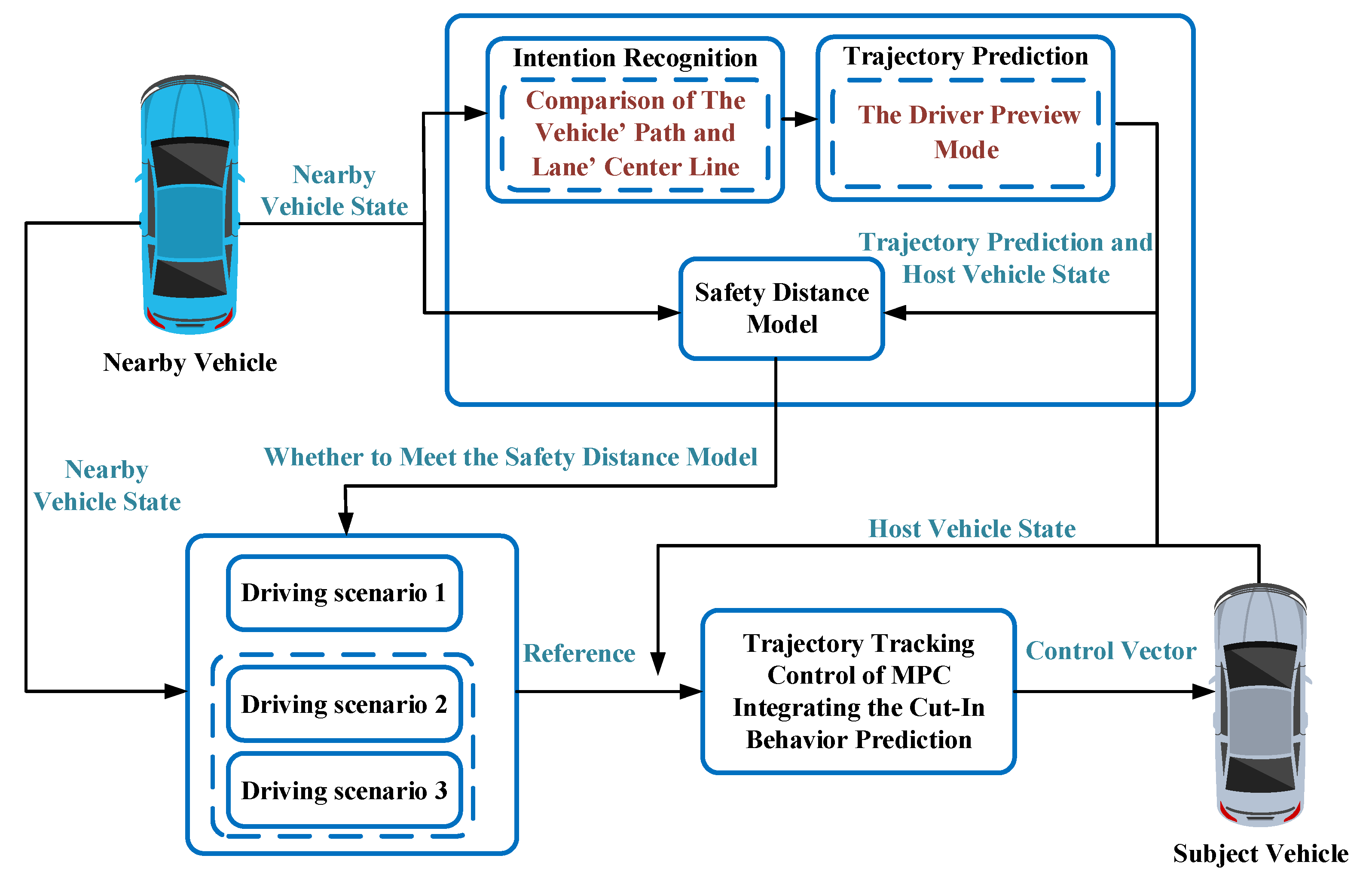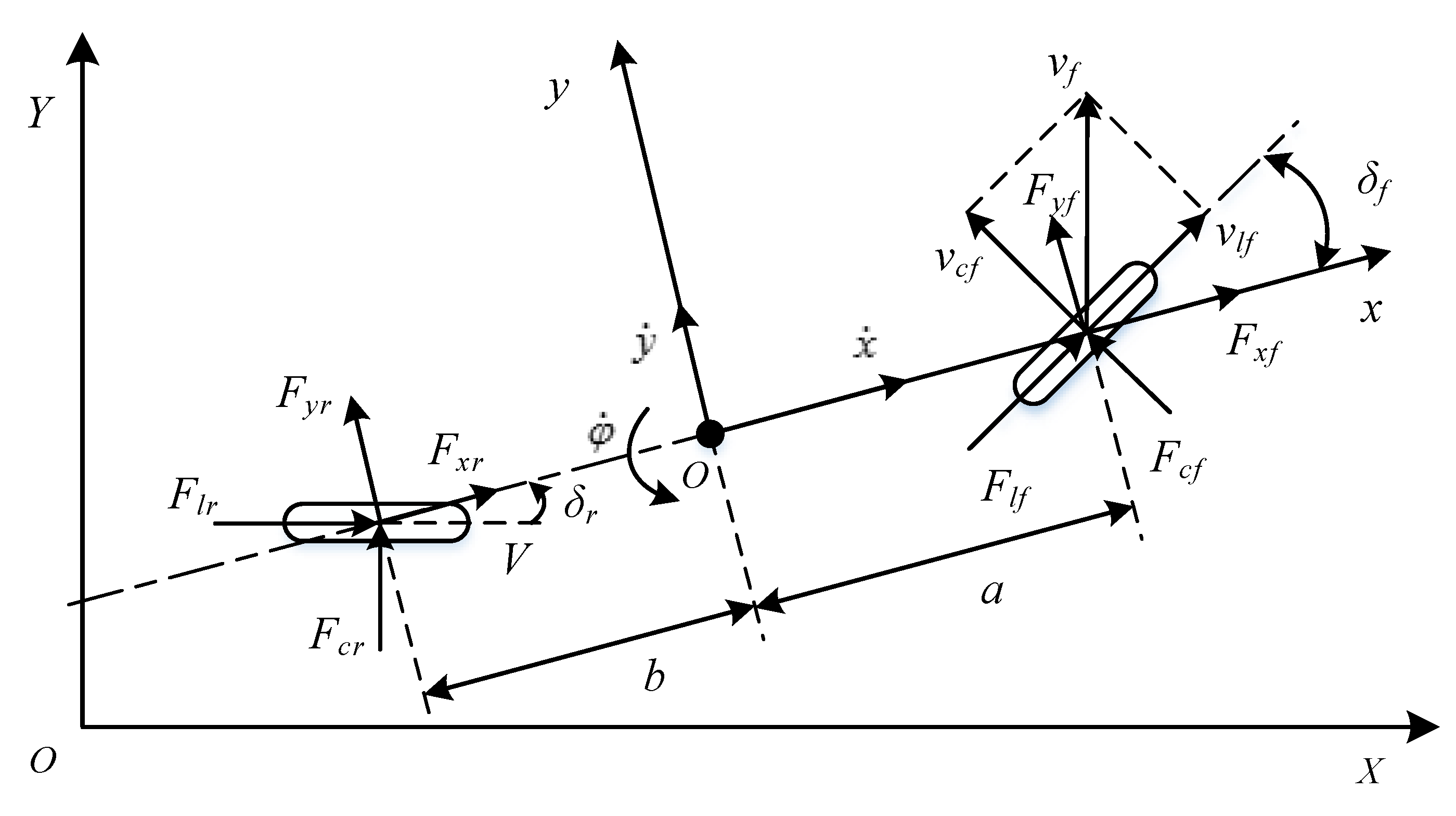Trajectory Tracking Control for Intelligent Vehicles Based on Cut-In Behavior Prediction
Abstract
:1. Introduction
- (1)
- Three driving scenarios are divided according to the behavior of the adjacent vehicle, and the cut-in intention is recognized by considering similarity between the path of the adjacent vehicle and the center line of the lane where it is located. After cut-in intention recognition, the trajectory prediction method based on the driver preview model for the cut-in vehicle is proposed, which is used as a reference for subject vehicle to realize the coordinated control between the subject vehicle and the cut-in vehicle;
- (2)
- The safety distance model of the cut-in vehicle is proposed. Comprehensively, considering the movement state of the vehicle, the preceding vehicle ahead in the lane and the cut-in vehicle, the safety distance model of the cut-in vehicle is established, which performs the conversion of the management driving scenarios, so that the vehicle control can be taken appropriately when the cut-in vehicle changes lanes;
- (3)
- Facing the cut-in vehicles in different driving scenarios, cut-in prediction trajectory is integrated into a trajectory planning control method based on MPC. In the process of controlling the subject vehicle, the cut-in behavior of the adjacent vehicle is predicted and considered in advance, while ensuring the safety and driving comfort of the subject vehicle. At the same time, the subject vehicle is controlled on the optimal trajectory.
2. Cut-In Scenarios Classification and Cut-In Behavior Prediction
2.1. Cut-In Scenarios Classification
2.2. Cut-In Intention Recognition
2.3. Cut-In Vehicle Trajectory Prediction
3. The Cut-In Vehicle Safety Distance Model
3.1. The Safe Distance Model of the Cut-In Vehicle
3.1.1. The Minimum Longitudinal Safety Distance between the Cut-In Vehicle L and the Preceding Vehicle P
3.1.2. The Minimum Longitudinal Safety Distance between the Cut-In Vehicle L and the Subject Vehicle H
4. Trajectory Tracking Control
4.1. Subject Vehicle Model
4.2. Reference Trajectory Generation
4.2.1. Driving Scenario 1
4.2.2. Driving Scenario 2
4.2.3. Driving Scenario 3
4.3. Main Vehicle Objective Function and Constraint Establishment
5. Simulation Results and Analysis
5.1. Driving Scenario 1
5.2. Driving Scenario 2
5.3. Driving Scenario 3
5.4. Method Application Evaluation
6. Conclusions
Author Contributions
Funding
Conflicts of Interest
References
- Yang, J.; Coughlin, J.F. In-vehicle technology for self-driving cars: Advantages and challenges for aging drivers. Int. J. Automot. Technol. 2014, 15, 333–340. [Google Scholar] [CrossRef]
- Yoshida, H.; Omae, M.; Wada, T. Toward next active safety technology of intelligent vehicle. J. Robot. Mechatron. 2015, 27, 610–616. [Google Scholar] [CrossRef]
- Hu, C.; Wang, R.; An, F.Y.; Chen, N. Output constraint control on path following of four-wheel independently actuated intelligent ground vehicles. IEEE Trans. Veh. Technol. 2016, 65, 4033–4043. [Google Scholar] [CrossRef]
- Chen, C.P.; Guo, J.H.; Guo, C. Adaptive Cruise Control for Cut-In Scenarios Based on Model Predictive Control Algorithm. Appl. Sci. 2021, 11, 5293. [Google Scholar] [CrossRef]
- Kumar, P.; Perrollaz, M.; Lefevre, S.; Laugier, C. Learning-Based Approach for Online Lane Change Intention Prediction. In Proceedings of the 2013 IEEE Intelligent Vehicles Symposium, Gold Coast City, QLD, Australia, 23–26 June 2013. [Google Scholar]
- Kim, I.H.; Bong, J.H.; Park, J.; Park, S. Prediction of driver’s intention of lane change by augmenting sensor information using machine learning techniques. Sensors 2017, 17, 1350. [Google Scholar] [CrossRef] [PubMed] [Green Version]
- Liu, P.; Kurt, A.; Redmill, K.; Ozguner, U. Classification of Highway Lane Change Behavior to Detect Dangerous Cut-in Maneuvers. In Proceedings of the Transportation Research Board (TRB) 95th Annual Meeting, Washington, DC, USA, 10–14 January 2016. [Google Scholar]
- Jo, K.; Lee, M.; Kim, J.; Sunwoo, A. Tracking and behavior reasoning of moving vehicles based on roadway geometry constraints. IEEE Trans. Veh. Technol. 2016, 18, 460–476. [Google Scholar] [CrossRef]
- Kim, B.; Kang, C.M.; Kim, J.; Lee, S.H.; Chung, C.C.; Choi, J.W. Probabilistic Vehicle Trajectory Prediction over Occupancy Grid Map via Recurrent Neural Network. In Proceedings of the International Conference on Intelligent Transportation Systems, Yokohama, Japan, 16–19 October 2017. [Google Scholar]
- Deo, N.; Trivedi, M.M. Convolutional Social Pooling for Vehicle Trajectory Prediction. In Proceedings of the IEEE Conference on Computer Vision and Pattern Recognition Workshops, Salt Lake City, UT, USA, 18–23 June 2018. [Google Scholar]
- Garone, E.; Nicotr, M.; Ntogramatzidis, L. Explicit reference gov-ernor for linear systems. Int. J. Control 2018, 1, 1415–1430. [Google Scholar]
- Nicotra, M.; Garone, E. The explicit reference governor: A general framework for the closed-form control of constrained nonlin-ear systems. IEEE Control Syst. 2018, 3, 89–107. [Google Scholar] [CrossRef]
- Hosseinzadeh, M.; Cotorruelo, A.; Limon, D.; Garone, E. Constrained Control of Linear Systems Subject to Combinations of Intersections and Unions of Concave Constraints. IEEE Control. Syst. 2019, 3, 571–576. [Google Scholar] [CrossRef]
- Forsgren, A.; Gill, P.E.; Wright, M.H. Interior Methods for Nonlinear Optimization. SIAM Rev. 2002, 44, 525–597. [Google Scholar] [CrossRef] [Green Version]
- Panagou, D.; Stipanovic, D.M.; Voulgaris, P.G. Multi-Objective Control for Multi-Agent Systems Using Lya-Punov-Like Barrier Functions. In Proceedings of the 52nd IEEE Conference on Decision and Control, Firenze, Italy, 10–13 December 2013. [Google Scholar]
- Merabti, H.; Belarbi, K.; Bouchemal, B. Nonlinear predictive controlof a mobile robot: A solution using metaheuristcs. J. Chin. Inst. Eng. 2016, 39, 282–290. [Google Scholar] [CrossRef]
- Du, X.; Htet, K.K.K.; Tan, K.K. Development of a genetic-algorithm-based nonlinear model predictive control scheme on velocity and steering of intelligent vehicles. IEEE Trans. Ind. Electron. 2016, 63, 6970–6977. [Google Scholar] [CrossRef]
- Krishnamoorthy, D.; Suwartadi, E.; Foss, B.; Skogestad, S.; Jaschke, J. Improving scenario decomposition for multistage MPC using a sensitivity-based path-following algorithm. IEEE Control Syst. Lett. 2018, 2, 581–586. [Google Scholar] [CrossRef]
- Dixit, S.; Montanaro, U.; Fallah, S.; Dianati, M.; Oxtoby, D.; Mizutani, T.; Mouzakitis, A. Trajectory Planning for Intelligent High-Velocity Overtak-ing Using MPC with Terminal Set Constraints. In Proceedings of the 21st International Conference on Intelligent Transportation Systems (ITSC), Maui, HI, USA, 4–7 November 2018. [Google Scholar]
- Falcone, P.; Borrelli, F.; Asgari, J.; Tseng, H.E.; Hrovat, D. A model Predictive Control Approach for Combined Braking and Steering in Intelligent Vehicles. In Proceedings of the 2007 Medoterranean Conference on Control & Automation, MED’07, Athens, Greece, 27–29 June 2007. [Google Scholar]
- Borrelli, F.; Falcone, P.; Keviczky, T.A.; Hrovat, D. MPC-based approach to active steering for intelligent vehicle systems. Int. J. Veh. Intell. Syst. 2005, 4, 265–291. [Google Scholar]
- Park, M.; Lee, S.; Han, W. Development of steering control system for intelligent vehicle using geometry-based path tracking algorithm. ETRIJ 2015, 37, 617–625. [Google Scholar] [CrossRef]
- Soudbakhsh, D.; Eskandarian, A. A Collision Avoidance Steering Controller Using Linear Quadratic Regulator; SAE Technical Paper; SAE International: Detroit, MI, USA, 2010. [Google Scholar]
- Tagne, G.; Talj, R.; Charara, A. Higher-Order Sliding Mode Control for Lateral Dynamics of Intelligent Vehicles, with Experimental Validation. In Proceedings of the 2013 IEEE Intelligent Vehicles Symposium, Gold Coast City, QLD, Australia, 23–26 June 2013. [Google Scholar]
- Ganzelmeier, L.; Helbig, J.; Schnieder, E. Robustness and Performance Advanced Control of Vehicle Dynamics. In Proceedings of the 2001 IEEE Intelligent Transportation Systems, Oakland, CA, USA, 25–29 August 2001. [Google Scholar]
- Eom, S.I.; Kim, E.J.; Shin, T.Y. The Robust Controller Design for Lateral Control of Vehicles. In Proceedings of the 2003 IEEE/ASME International Conference on Advanced Intelligent Mechatronics, Como, Italy, 8–12 July 2001; IEEE Conference Publications: Kobe, Japan, 2003. [Google Scholar]
- Houenou, A.; Bonnifait, P.; Cherfaoui, V.; Yao, W. Vehicle Trajectory Prediction based on Motion Model and Maneuver Recognition. In Proceedings of the IEEE/RSJ International Conference on Intelligent Robots and Systems (IROS), Tokyo, Japan, 3–8 November 2013. [Google Scholar]
- Chen, Y.; Wang, J. Personalized Vehicle Path Following Based on Robust Gain-Scheduling Control in Lane-Changing and Left-Turning Maneuvers. In Proceedings of the 2018 Annual American Control Conference (ACC), Milwaukee, WI, USA, 27–29 June 2018. [Google Scholar]
- Schnelle, S.; Wang, J.; Su, H.; Jagacinski, R. A personalize driver steering model capable of predicting driver behaviors in vehicle collision avoidance maneuvers. IEEE Trans. Human Mach. Syst. 2017, 47, 625–635. [Google Scholar] [CrossRef]
- Sága, M.; Blatnický, M.; Aško, M.V.; Dižo, J.; Kopas, P.; Gerlici, J. Experimental Determination of the Manson−Coffin Curves for an Original Unconventional Vehicle Frame. Materials 2020, 13, 4675. [Google Scholar] [CrossRef] [PubMed]
- Sentyakov, K.; Peterka, J.; Smirnov, V.; Bozek, P.; Sviatskii, V. Modeling of Boring Mandrel Working Process with Vibration Damper. Materials 2020, 13, 1931. [Google Scholar] [CrossRef] [PubMed] [Green Version]
- Sága, M.; Jakubovičová, L. Simulation of vertical vehicle non-stationary random vibrations considering various speeds. J. Sil. Univ. Technol. Ser. Transp. 2014, 84, 115–118. [Google Scholar]
- Chen, Y.M.; Hu, C.; Wang, J.M. Human-Centered Trajectory Tracking Control for Intelligent Vehicles with Driver Cut-In Behavior Prediction. IEEE Trans. Intell. Transp. Syst. 2019, 68, 8461–8471. [Google Scholar]
- Božeka, P.; Lozkinb, A.; Gorbushinc, A. Geometrical Method for Increasing Precision of Machine Building Parts. In Proceedings of the International Conference on Manufacturing Engineering and Materials, Nový Smokovec, Slovakia, 6–10 June 2016. [Google Scholar]
















| Left Lane Change | Right Lane Change | |
|---|---|---|
| Detection | 100% | 100% |
| Mean time before detection | 1.21 s | 1.18 s |
| Parameter | Value |
|---|---|
| Range Accuracy (m) | ±0.02 |
| Detection Sensitivity Range (m) | 120 |
| Azimuth Field of View (°) | 140 |
| Angle Accuracy (deg) | ±0.3 |
| Doppler Accuracy (m/s) | ±0.02 |
| Variables | Value |
|---|---|
| Simulation termination time (s) | 100 |
| Simulation step (s) | 0.02 |
| Actual simulation time (s) | 54.67 |
| RAM (MB) | 9286 |
Publisher’s Note: MDPI stays neutral with regard to jurisdictional claims in published maps and institutional affiliations. |
© 2021 by the authors. Licensee MDPI, Basel, Switzerland. This article is an open access article distributed under the terms and conditions of the Creative Commons Attribution (CC BY) license (https://creativecommons.org/licenses/by/4.0/).
Share and Cite
Chen, C.; Guo, J.; Guo, C.; Li, X.; Chen, C. Trajectory Tracking Control for Intelligent Vehicles Based on Cut-In Behavior Prediction. Electronics 2021, 10, 2932. https://doi.org/10.3390/electronics10232932
Chen C, Guo J, Guo C, Li X, Chen C. Trajectory Tracking Control for Intelligent Vehicles Based on Cut-In Behavior Prediction. Electronics. 2021; 10(23):2932. https://doi.org/10.3390/electronics10232932
Chicago/Turabian StyleChen, Chongpu, Jianhua Guo, Chong Guo, Xiaohan Li, and Chaoyi Chen. 2021. "Trajectory Tracking Control for Intelligent Vehicles Based on Cut-In Behavior Prediction" Electronics 10, no. 23: 2932. https://doi.org/10.3390/electronics10232932






